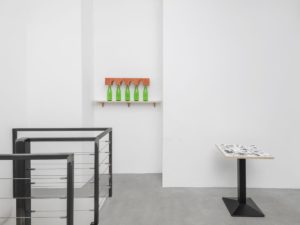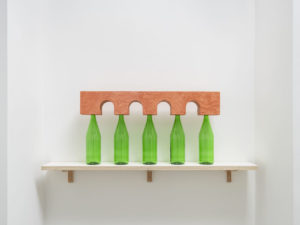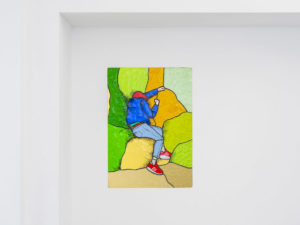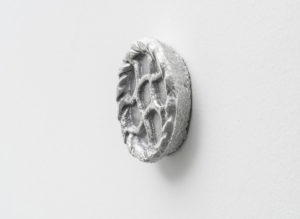“Trattogalleria” – the first exhibition of Claudio Corfone (Foggia, 1985) in Milan, in the Arrivada spaces, has the flavor of an aphorism that unfolds through a journey. Inside, as in Stefano Benni’s Sports Bar, you can find: spaghetti with tomato and pecorino cheese, Samuele Menin – the curator with a thick beard -, the green and blue neon sign and many other works with titles full of crazy humor.
Only the pinball machine and the Sip coin-operated telephone are missing. Shading neon pushes you into the depths of a motorway tunnel, similar in length to that of the Frejus Tunnel (the longest in Italy), advising you to make yourself comfortable, select your favorite playlist and enjoy the journey. Claudio Corfone can only be “Corphonian” (Each one of his actions has been called a” Corfonade”).
He is one of those few artists who proves to be open in the face of situations (which is rare and difficult), escaping completely from any label. That’s because, without classifications or hierarchies, in a magmatic and overwhelming mixture, he uses word, sculpture, colors, oxymorons, action, painting; and because he decides to transform an active exhibition space into a restaurant. “Just to prepare a pasta.” It may be a historic brand, but “Corfone tomato spaghetti” is a case in point of the Boutade à la Corfon.
It’s ten p.m. o’clock on a pre-Christmas Saturday evening in South Milan and the artist shows off his culinary skills with a small group of diners perched on the Egoriferiti Tables (2019). Around a wooden table 55x75x55 cm, fragments of life, juicy anecdotes and characters that gather in the social sphere of Corfone – the friend photographer with a bewitching gaze, art critic with the dog Felice on a leash and the young sly collector with pullovers – designed with verve, perspicacity and also (self) irony. Mind you, this is not a journey through a single space-time dimension, with a compact and happy ending.
The morphology of Propp’s fairy tale, with its 31 unalterable sequences in the order, goes head over heels. We are always in the phase of breaking the initial balance. The practicable surfaces are sometimes smooth and straight, sometimes uneven and rounded, other times the dimensions of the experience are environmental. It happens with Fresco Catacomba, a mural painting with bright colors and rippled shapes. Times dilate, tangle in the stumbling blocks of Corfone’s autobiographical narrative.
Rather, it is a poetic-visual Grand-Tour (Titoli Dipinti, 2019) from Ascoli Satriano – passing through Dentecane, the home of nougat in the world – to the tart. What? That’s right. The icing on the “Trattogalleria” cake is the Cratere Crostatina: the aluminum mold of a cocoa tart (attention: not jam) made by a Turin foundry. If you are interested, the contact number is imprinted in permanent marker on the cartoon drawings of a self-referenced table. It is plausible to imagine Corfone pushing the keys of a huge telephone and saying: “Hi, I need to make a tart.” An intuition with a perfect circular shape almost embedded in the wall, like a rose window stands on the Gothic cathedral and like a glass window stands on a poster. The textures and the frame of the tart, in fact, expand, reproducing the work of the Poster Glass with vibrant freshness. The portrait – the most autobiographical of all – by Claudio Corfone is engraved on a handmade glass pane.
After a Lucullian meal, “he” lies on the green of a lawn. If it weren’t for the red Adidas on his feet and the hooded sweatshirt, the figure of Corfone could remember a Pietà by Michelangelo in his dramatic pose – and not, instead, a young boxer stretched out by a well-aimed blow who dreams of delivering a “direct with riser “. If it were not for certain subtle thicknesses and signs of transparency revealed to a clinical eye, the Stained Glass Poster would appear as a flat and dazzling screen of a smartphone or in all the two-dimensionality of a poster.
In both cases, what is rigid is removed and the Corfonian fragrance – inspiration from the scent of Puglia – expands. So, to return to the initial aphorism: in art, as in life, it is necessary to break down – and Corfone does it with ease, mixed joie de vivre, necessarily, with divine melancholy – the forms of stiffening and crusting and continue to “chase the riddle”.
Petra Chiodi
Info:
Fino al 31 gennaio 2020
Galleria Arrivada
Via Pier Candido Decembrio, 26 Milano
Orari di apertura: su appuntamento
 Claudio Corfone, Trattogalleria, installation view at Arrivada
Claudio Corfone, Trattogalleria, installation view at Arrivada
 Claudio Corfone, Acquedotto Romano, 2019. Polistirolo stuccato, pigmenti, bottiglie di vetro. 78 x 10 x 40 cm.
Claudio Corfone, Acquedotto Romano, 2019. Polistirolo stuccato, pigmenti, bottiglie di vetro. 78 x 10 x 40 cm.
 Claudio Corfone, Titoli Dipinti, 2019. Idropittura su tela di lino. 145 x 100 cm.
Claudio Corfone, Titoli Dipinti, 2019. Idropittura su tela di lino. 145 x 100 cm.
 Claudio Corfone, Cratere Crostatina, 2019. Alluminio. Diametro 7,5 cm
Claudio Corfone, Cratere Crostatina, 2019. Alluminio. Diametro 7,5 cm
For all the images: Ph Cosimo Filippini © Claudio Corfone e Galleria Arrivada

is a contemporary art magazine since 1980






NO COMMENT